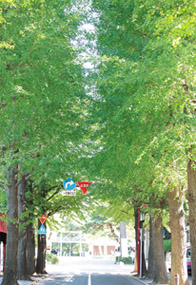
Home > About SEIJO > About SEIJO
About SEIJO
Seijo University is a private university located in Seijo, Setagaya-ku, Tokyo, Japan.
Seijo has its origins in 'Seijo Gakuen' Seijo educational Institutes, which was founded in 1917, by Dr. Masataro Sawayanagi. After the period of 'Seijo Higher School', under the pre-World War II education system, the present Seijo University was established in 1950. Since then, we have adhered to the founding philosophy, which respects the individuality and creativity of our students, particularly by retaining small-class education. We have endeavored to provide education of the highest quality by encouraging initiative and independent thought, through close interaction between students and professors. Our free and relaxed learning atmosphere cultivates the intellect, sensitivity and sophistication, enabling us to send a great number of well-prepared graduates into society.
The area known as Seijo, in Setagaya Ward, is approximately fifteen minutes by rapid train from the central Shinjuku area, which means Seijo Gakuen is located in a quiet residential neighborhood in comfortable proximity to the city center. The school is also so close to the station that you can even see the university buildings as the train pulls in. This convenience factor makes Seijo an ideal location to commute to for students living off campus.
In addition to its easy access to the city center, Seijo is surrounded by a lush natural environment, reminiscent of the old natural expanse of the Musashino area, and the greenery here is an unusual occurrence in the city of Tokyo. The Seijo Pond site on the grounds has even been listed as one of the 100 Best Views of Setagaya. At Seijo Gakuen, students enjoy nature on a daily basis, which is yet another factor that makes our campus highly conducive to growth and learning.

At the present time, Seijo is well-known as a quiet residential area. Seijo Gakuen moved to this barren space in 1925, when the area was called Kinuta Village, Kita-tama, under the jurisdiction of Tokyo Prefecture. Records show that the school purchased and divided the land, upon which the college town was built.
The Odakyu Line was launched in April 1927, from which time the name "Seijo Gakuen" was used for the station name. In 1936, when the area was absorbed into the Tokyo metropolitan, the district name was changed to "Seijo-machi, Setagaya Ward."
"Kinuta Village" thus became "Seijo," taking the name of our school. Cherry blossom, gingko, and other seedlings planted by Seijo Gakuen students at the time the school was relocated here now decorate the town throughout the seasons, and are currently something of a local seasonal attraction. Up until the mid-fifties and early sixties, the line of cherry blossom trees stretching north from the North Exit of Seijo Gakuen to intersect with gingko trees was called "Sawayanagi Street," a name symbolic of how integral a part Seijo Gakuen is of the town of Seijo.